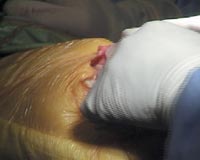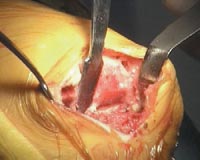AAHKS issues statements on MIS, small-incision TJR surgery
The group plans to update the statements periodically and wants large-scale studies done to validate the techniques’ efficacy.
The American Association of Hip and Knee Surgeons has issued two statements about minimally invasive total knee and total hip replacement surgery, particularly those involving one or two small incisions. Officials at the Park Ridge, Ill.-based organization said it produced the statements, one each for patients and surgeons, to provide more information about these procedures to both audiences.
In the United States a very limited number of orthopedic surgeons perform minimally invasive total hip replacement (THR) and total knee replacement (TKR) through small incisions. This is from among an estimated 800,000 THR and TKR procedures performed annually, according to a press release issued by the American Association of Hip and Knee Surgeons (AAHKS).
But for a variety of reasons, including recent direct-to-consumer advertising, these procedures are gaining popularity. “The new techniques are thought to have fewer effects on soft tissue and bones,” officials said.
|
COURTESY OF PETER BONUTTI |
More research needed
The statements were issued in August. Their purpose was “to provide important information to surgeons and patients about the emerging use of these techniques in hip and knee joint replacement surgery,” AAHKS president Richard F. Santore, MD, said in the release.
“We have concluded that minimally invasive surgery has not yet been validated with large-scale studies. More research is needed to better understand if this type of procedure will benefit most joint replacement patients, just a select group of patients or relatively few patients.”
The AAHKS formed a task force earlier this year after the board of directors discussed the subject extensively at its March meeting in San Francisco. That task force prepared the statements. “The board felt it was timely and important that something be developed,” said Brian J. McGrory, MD, who chaired the task force.
The group held two conference calls and corresponded by email for more than 12 weeks to develop the statements.
Task force formed
Task force members included John J. Callaghan, MD; William J. Robb III, MD; Joshua J. Jacobs, MD; Matthew Kraay, MD; and Ray Wasielewski, MD. Jeanie Kennedy and Donna Toohey of the American Academy of Orthopaedic Surgeons (AAOS) Research and Scientific Affairs Department, and industry representative Roy Crowninshield, PhD, made contributions after the draft documents were developed.
The five-page surgeon statement defines terminology and includes advantages, disadvantages, patient selection criteria and other areas of consideration.
The corresponding three-page document for patients contains definitions and areas to be covered during patient-surgeon discussions. According to Robb, who was on the task force, the patient statement was meant to be informative and includes disadvantages, as well as advantages.
Robb, a member of the joint reconstruction section of Orthopedics Today's editorial board, said he agrees with the statements’ content. They meet a need for unbiased information about these new techniques and their outcomes, he said. “None or little was available through any professional medical organizations … I agree with the need to provide information to patients and surgeons about evolving and new technologies or techniques.”
Evolving documents
The main goals for creating the statements were they be completed quickly, based upon information currently available, but be able to be updated as needed, McGrory told Orthopedics Today. “We were not going to go the route of the National Institutes of Health consensus statements … We actually have a plan to revisit this within three months in order to see what feedback we’ve had, what new information is available. We feel it’s imperative to revisit this.”
The statements are fairly balanced and suggest areas where more information is needed, said McGrory, of Portland, Maine, one of the first surgeons in New England to be trained by Zimmer on the two-incision THR technique and perform it. “One of the punch lines of the statements … is that it’s still unclear, even if there are advantages, if it’s just a select group of patients or a select group of surgeons that can get those advantages.”
Seeking feedback
Robb and McGrory said the statements were well received by their patients.
When McGrory presented them at a recent meeting of the Maine Society of Orthopaedic Surgeons members reacted positively. “Everybody felt that these would be helpful for their patients and are kind of the breath of fresh air as far as the marketing of this is concerned.”
The task force plans to obtain comments from the AAOS and with its support hopes to issue a joint statement on the subject in the future.
Task force members Callaghan and Jacobs also serve on the Orthopedics Today editorial board.
For more information:
- The AAHKS surgeon and patient advisory statements on minimally invasive joint replacement surgery may be viewed at www.aahks.org.


